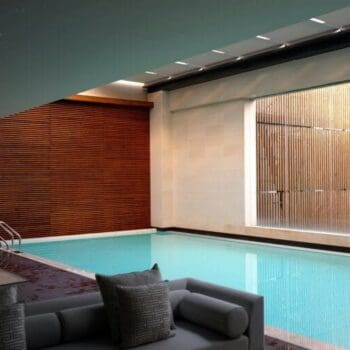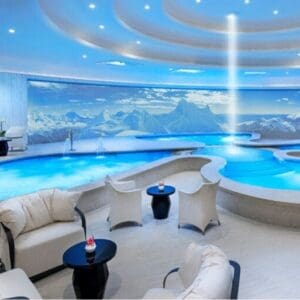 People booking hotel stays now look for something beyond basic comfort. They want their entire stay to support their well-being, from restful sleep to healthy meals. When hotels build wellness into each part of their service, they create memorable stays that keep guests coming back.
People booking hotel stays now look for something beyond basic comfort. They want their entire stay to support their well-being, from restful sleep to healthy meals. When hotels build wellness into each part of their service, they create memorable stays that keep guests coming back.
Good wellness programs do more than offer spa treatments and gym access — they offer a variety of mindfully selected amenities and services. The best approaches turn routine moments into chances for guests to feel better and more energized. Hotels that make wellness a natural part of everything they do, from smooth arrivals to healthy room service options, give their guests exactly what they’re looking for.
Welcoming guests with stress-free check-ins
A guest’s first moments at a hotel shape their entire stay, setting the foundation for their wellness experience. The check-in process builds trust and sets expectations, while the lobby layout creates lasting impressions that ripple through the rest of their time on the property. Hotels that blend efficient service with calming spaces help guests shed travel stress and start their stay feeling centered and welcomed.
The front desk experience reaches its full potential when it combines smart technology with genuine personal attention. Thoughtful design choices in lighting, sound, and scent work together to create spaces where guests naturally slow their pace, take deeper breaths, and begin to unwind.
Streamlined check-in solutions
Modern check-in should feel effortless and intuitive, putting guests in control of their arrival experience. Mobile apps, digital room keys, and tablet-based systems let guests move at their own pace while reducing common friction points that can create stress. When paired with staff members trained to recognize and respond to wellness priorities, these tools transform a routine process into a thoughtful introduction to the property.
Setting the right atmosphere
The lobby serves as both a wellness preview and a buffer between the outside world and the haven of the hotel. Lighting affects mood based on temperature, brightness, and color — so pick something soft and pleasant. Soft lighting follows natural daily rhythms, while carefully chosen background sounds create a subtle barrier against street noise and conversation. Plants, natural materials, and strategically placed seating areas invite guests to pause and reset, creating small moments of calm that set the stage for a rejuvenating stay.
Healthy dining options
Food choices deeply affect how guests feel during their stays, influencing everything from energy levels to sleep quality. When hotels expand their dining options beyond traditional offerings, they create opportunities for guests to maintain healthy habits.
Hotel restaurants play a pivotal role here, starting with breakfast and continuing through must-have late-night room service. By reimagining culinary experiencesthrough a wellness lens, properties help guests feel their best without sacrificing flavor or satisfaction. This attention to nutritious, satisfying options becomes a key differentiator that guests remember and seek out in future stays.
Crafting wellness-focused menus
A wellness-centered menu respects both traditional preferences and modern nutritional wisdom, offering choices that energize rather than drain guests. Fresh ingredients and thoughtful preparation methods let natural flavors shine, while flexible portions and timing options help guests eat in harmony with their bodies’ needs. By training staff to understand and communicate the benefits of menu choices, hotels turn each meal into an opportunity for guests to make informed decisions about their well-being.
Personalizing in-room dining
Room service becomes a powerful wellness tool when it strives to be more than conventional hotel fare. Digital ordering systems that remember preferences and dietary needs make it simple for guests to maintain healthy eating patterns, even during late meetings or early morning calls. Careful packaging, temperature control, and presentation ensure that healthy choices feel as appealing and satisfying as traditional room service comfort foods.
In-room wellness amenities
Small but purposeful changes to room design and amenities help create restful spaces supporting guest well-being rather than being a pit stop. When hotels think beyond basic comfort to consider the full spectrum of wellness, they convert standard rooms into retreats that guests look forward to returning to each evening.
The most effective in-room wellness strategies work quietly in the background, enhancing the guest experience without demanding attention or effort. From air quality and temperature control to lighting that matches natural cycles, these foundational elements create an environment where wellness feels effortless and intuitive. By carefully selecting and placing amenities, hotels help guests maintain their healthy routines while discovering new ways to care for themselves.
Sleep enhancement strategies
Good sleep affects every aspect of a guest’s stay, from mental clarity to physical comfort. High-quality mattresses and bedding create ideal sleeping conditions, while adjustable temperature settings and complete darkness options help guests rest deeply. Smart room controls put comfort choices at guests’ fingertips, making it simple to create their perfect sleep environment and wake up feeling energized.
Personal wellness tools
Private spaces become mini wellness centers when thoughtfully equipped with tools for both body and mind. Compact exercise equipment, meditation cushions, and wellness programming through the room’s entertainment system give guests flexible options for maintaining their routines. Digital guides for in-room stretching and mindfulness practices help travelers combat the physical and mental effects of long days, turning their rooms into personal studios for movement and relaxation.
On-site wellness activities
Physical activity and mental well-being programs give guests ways to grow stronger in both body and mind during their stays. Hotels that create varied wellness options make it simple for guests to maintain their usual routines or try new practices that might spark lasting changes. By offering scheduled activities and flexible options, properties help guests find their preferred path to feeling better.
Successful wellness programming responds to different fitness levels, time constraints, and personal preferences. Some guests seek structured classes that build community, while others prefer solo workouts that fit their schedules. When hotels provide clear information about available options and make participation simple, they remove barriers that often prevent guests from staying active while traveling.
Physical wellness offerings
Movement spaces work best when they combine quality equipment with diverse programming. Aquatic exercise, for instance, is a stellar way for fitness newbies or the mobility impaired to stay active in a low-impact environment. Experienced exercisers gravitate toward well-equipped cardio and strength training areas, but a variety tends to work best for covering all your bases.
Mental wellness services
Mental wellness services weave moments of peace throughout the guest experience. Travelers reset their minds in dedicated quiet spaces, join guided relaxation sessions, or simply connect with nearby nature spots. Beyond these everyday options, professional massage and mindfulness coaching sessions offer guests deeper restoration. For those who prefer privacy, mobile apps put self-guided practices at their fingertips, available whenever they need a moment of calm.
Final thoughts
Hotels win guest loyalty by making wellness feel natural and simple. Every detail matters, from a smooth arrival to quiet rooms and flexible workout choices, but none of it needs to be complicated. By considering guest well-being at each step, hotels create experiences that feel special without feeling forced. Properties that help guests feel their best during their stays build the kind of reputation that keeps rooms full and reviews glowing.




















